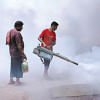What we are missing in our fight against dengue is data

Bangladesh has become crippled by the surge of dengue infections this year. As of August 12, at least 387 people died from the viral disease, potentially making 2023 the deadliest year for the country since 2000 when it started addressing the issue. According to the data provided by the Director General of Health Services (DGHS), there were 101,354 dengue cases in 2019, and on August 12, this number was at 82,506. The death toll is rising every day and is expected to continue to climb at least for the next couple of months, as studies show that the disease spreads the most during monsoon, from May to September. Government and non-government organisations have implemented many aggressive steps to tackle this disease. Many hospitals have repurposed their units to treat patients; government agencies have prioritised data collection and utilisation to fill needs; there are also rigorous educational campaigns through websites and social media to make the public aware of the crisis; test kits have been delivered to healthcare facilities; and healthcare providers have received training in triage and treatment. We seem to be doing a perfectly good job, but what are we lacking that could help us bring the situation under control?
If you look closely, we are significantly missing advanced technology and data-driven approaches in our handling of the crisis. Filling these gaps is critical to turn the tide of the dengue situation in Bangladesh.
Creating mobile apps to supplement government data collection and analysis could be a critical first step in fighting dengue. The DGHS data mentioned above provides details on the hospitalisation, mortality, morbidity, and overall impact of the disease across the county. Indeed, it is a significant resource to zone and prioritise measures and identify gaps. However, we must also develop mobile apps which will enable ordinary citizens to enter data when they detect the movement of Aedes, the mosquito responsible for breeding and spreading of the disease. Crowdsourcing of the data will provide real-time information on mosquito breeding sites, disease prevalence, and human movement patterns. Smartphones, an affordable device for average people in Bangladesh, can be a great tool for hosting these apps. The data collection and analysis on dengue will get significantly better when common people can be a part of it. The technique will facilitate a much better dynamic database to base on when creating policies, taking immediate actions, and preventive measures.
We also must adopt predictive modelling in tackling dengue. Predictive modelling will require combining historical data with prevailing environmental factors such as temperature, humidity and rainfall, allowing the development of early warnings to forecast dengue outbreaks. We can create various futuristic data models to enable early warnings of impending risks so the government, health authorities, communities, and other stakeholders can allocate necessary resources before the situation escalates. A predictive approach will significantly help our healthcare system prepare and respond to the dengue epidemic, reducing the human and economic toll of the illness.
In addition to data analytics, we can also deploy advanced technologies. Inexpensive drones equipped with precision sprayers can efficiently target breeding grounds of Aedes mosquitoes, reducing the traditional spraying, which often poses health risks. When combined with geolocation technologies, such as Geographic Information System (GIS) – which can assist in mapping dengue hotbeds – drones can spray insecticides deep into the sources of vectors. This approach will also reduce the use of traditional pesticides that are harmful to the environment.
We must also leverage telemedicine more widely to tackle this issue. This is an area where we are clearly lagging to address dengue. Reduction of human movement and more indoor time will deprive mosquitoes of the important links to spread the disease. Infected individuals can use telehealth, when possible, to receive medical advice, rather than being admitted into hospitals, which worsens the overall hospital conditions. Telehealth can reduce the strain on crowded local healthcare facilities when they take in many dengue patients.
We can even pursue more advanced genetic modification techniques to address the crisis in the long term. By genetically modifying mosquitoes, producing sterile Aedes, equipping them with preventative vaccines to transmit to humans, and releasing them into the environment, we can greatly reduce mosquito populations and their harmful impacts. The dengue issue is no longer a local crisis for Bangladesh; it is in fact a global phenomenon. The World Health Organization (WHO) warned that this year can be deadly for many countries and reach near the pandemic level for some in terms of dengue. Therefore, genetic modification of Aedes must be a collective effort of technologies from across the world.
We also need increased global collaboration on tackling mosquito-borne illnesses, rather than doing it all alone at home. In 2022, organisations like the WHO provided technical and material support to countries like Bangladesh to help them battle dengue. While the critical contribution of these organisations is recognised, we must also develop global networks of experts, researchers, scientists, and policymakers to collaborate on best practices and the latest knowledge in preventing dengue outbreaks. There is no treatment plan for dengue as of today. This approach can potentially lead to the development of vaccines and treatment for the illness. This partnership will not only promote top-notch approaches to fighting the ailment, but also ensure that no community is left behind.
As revolutionary as the approaches will be to get a better handle on dengue outbreaks, we must also prepare ourselves to address moral dilemmas and data privacy issues around implementing these techniques. For example, critics have opined that genetic modification, which is an emerging approach in Africa to fight mosquito-borne diseases, is unethical. We must strike the right balance between inventing and adopting new approaches to dengue and protecting the privacy of patients.
The fight against dengue is far from over. We must incorporate advanced technology and science into our struggles against dengue, which we are deeply lacking now. Technology and data-driven tools will put us ahead of the game by effectively equipping us to defeat the disease before it spreads.
ABM Uddin is a healthcare and IT consultant at the Florida Agency for Health Care Administration. Views expressed in this article are the author's own.

 For all latest news, follow The Daily Star's Google News channel.
For all latest news, follow The Daily Star's Google News channel. 








Comments